Business and pleasure: cultural exchange
Long after the rush for gold had subsided, the French community in Australia continued to prosper. Following the devastating Franco-Prussian War (1870-1871), a gradual increase in French Australian trade brought a growing number of French settlers to the colony.
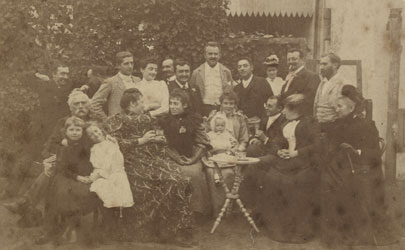
Detail from Boivin family, c. 1890
Photograph
By the early 1890s there were over 4000 French-born residents in Australia, almost half of them in NSW. From the 1880s to the present day, NSW has attracted over 40% of Australia's French migrants.
Bond Street and the woolbuyers
French and Belgian textile companies were anxious to organise direct sales with Australian wool producers and, from 1852, they began to send representatives to the colonies. Wool-trading companies such as Leroux, Masurel, Caulliez and Mathon-Bertrand eventually established permanent offices in Australia. These were soon joined by a French bank (1881) and a shipping line (1882).
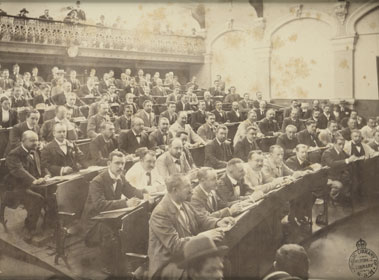
Detail from Wool buyers in the sale rooms, Sydney
Photograph SPG/Wool Sales
Due to the rapid expansion of the French community in Australia, the French Consulate was upgraded to a Consulate-General in 1892, and a French language newspaper, Le Courrier australien, was launched.
In order to consolidate the infrastructure of the French community, the Consulate-General moved to the Bond Street Chambers in Sydney, which also housed other local French associations, such as the French Benevolent Society (1891), the Alliance Française and the French Chamber of Commerce (1899). All continue to operate today.
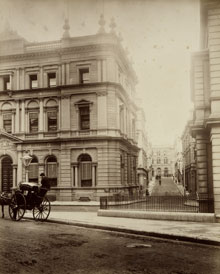
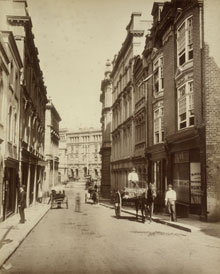
Above left: Bond Street, west, 1886, by William Slade, photograph XV/ST BON/2
Above right: Bond Street, east, 1886, by William Slade, photograph XV/ST BON/1
Woolbuyers constituted the active core of the local French colony, and their prestige and influence continued to expand in the 20th century. While Melbourne was initially the larger wool-selling centre, Sydney gradually took precedence. French business activity also centred around meeting places patronised by expatriates.
Patriotic gestures: Bastille Day and war service
From 1889 Sydney's French community celebrated their Fête Nationale with an annual gala picnic. The day commemorates the storming of the Bastille, on 14 July 1789, which signalled the start of the French Revolution. Originally held at the Sir Joseph Banks Hotel, Botany, in 1907 the venue was moved to Clifton Gardens, on Sydney's north shore.
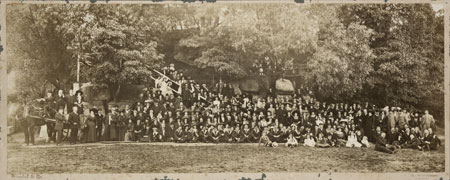
14th July picnic at Clifton Gardens, Sydney, by Kimbel & Co.
Photograph MLMSS 6586/ 2X (3)
All French citizens are required by law to serve their homeland in times of war. Men return to France to enlist while wives and mothers raise funds and prepare comfort packages for the soldiers and their families. When World War I broke out, seven members of the Playoust family of woolbuyers went to fight for France - three did not return.
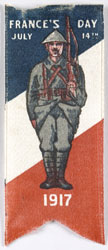
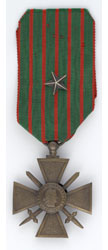
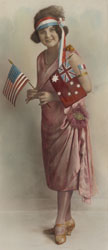
Above left: Fund raising ribbon, France's Day, c.1917, printed silk R759 (p)
Above center: Medal, Croix de Guerre, awarded to Jacques Playoust, c.1917
Silk and bronze MLMSS 6586/1
Above right: Marie-Celeste de Villentroy, c.1925, by Albert de Villentroy
Hand-coloured photograph PXD 666/ v.1/ 42
The French Australian League of Help was founded by Marie-Therese Playoust in December 1914, to provide comforts for French troops and their families. War relief activities involved the manufacture of clothing and organisation of fortnightly shipments of goods to France, as well as fundraising drives like 1917 France's Day.
During World War II, the ships and crews of the French Pacific Fleet were frequent visitors to Australian ports. Following the French Government's capitulation to Germany in 1940, members of the Australian French Community mobilised behind General de Gaulle's Free French Movement - André Brenac, a former woolbuyer, was de Gaulle's personal representative in Australia.
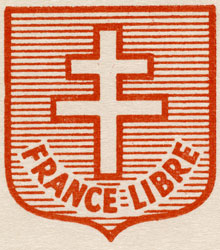
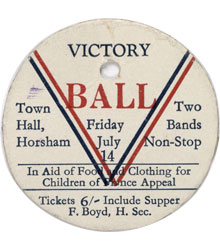
Above left: Detail from Cross of Lorraine, Free French Forces logo, c.1940
Manuscript MLMSS 2586
Above right: Medallion, Fund raising ball, 14/7/1945, printed ephemera MLMSS 2586
Relief agencies such as the French Australian League of Help were re-commissioned during World War II and, after peace was declared in Europe in May 1945, contingents from the Free French Forces joined Australian troops in the 1946 Victory Day parade.
Café society: food and fashion
Until the 1970s the nucleus of French society in Australia was formed by a small group of French and Belgian woolbuyers, surrounded by bankers and other businessmen, the consular corps, and of course their wives and families. Their objective was to enhance France's image and prestige in the host country, bringing a certain French flavour to local fashions, dining and fund-raising balls. The most famous member of this social set was charity queen Nola Dekyvère - ironically, the Australian half of a fashionable French-Australian couple from the woolbuying circles.
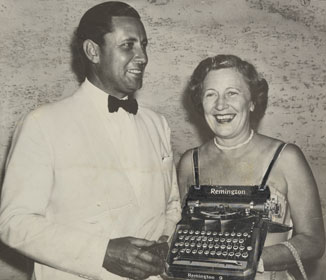
Marcel Dekyvere, wool business manager and his 'secretary', Nola, c.1950, by Jimi Bancks
Photograph collage PXE 750/ v.2/ 7
In 1938, the Princes Restaurant opened in Martin Place, Sydney, and highlighted French flair for mixing business and pleasure. Serving fine French cuisine, it soon became Sydney's premier dining destination. A popular meeting place for the local French community, society 'ladies who lunched' were regularly photographed there wearing fashions by Sydney-based couturier Madame Pellier and hats by French Countess, turned milliner, Henriette Lamotte. While Oh, for a French Wife!, published in 1952, encouraged Australian hostesses to entertain at home in the French way.
When Jacqueline Playoust married Brian Dwyer in 1951, she was following the tendency of French Australians to wed outside their cultural group. She persuaded Max Dupain, the famous Australian commercial photographer, to capture her wedding day on film, and asked the local patissierie to make a traditional French croquembouche wedding cake for the occasion.
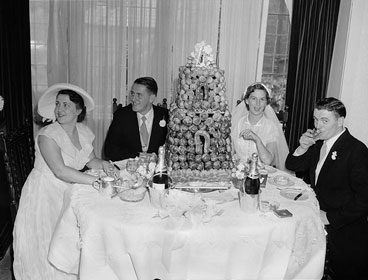
Playoust/Dwyer wedding with croquembouche, Sydney, 27/1/1951, by Max Dupain
Glass negative ON 249/28/22
Many Australians continue to associate France with luxury products like wine, fashion, perfume and food, but post war Australia has also provided a wealth of trade and investment opportunities for French businesses and technology. The gradual reversal of the balance of trade between the two countries was partly due to a decline in France's need of Australian primary produce, especially wool, but also to the growing presence of French companies in the Australian market. This was facilitated by the activities of a rejuvenated French-Australian Chamber of Commerce.
At the dawn of the 21st century, the French Consul-General has estimated that there are over 55,000 French residents and settlers (including second generation settlers) in Australia, of whom 45% are living in NSW.





